This post is background research for my new book: “30 Philosophers: A New Look at Timeless Ideas.” It covers the family of Marcus Aurelius with a focus on the women. When researching Marcus Aurelius, you quickly discover there is a lot of bad information out there!
Why this post? Well, I identify as an Epicurean-Stoic, so learning about the Roman era is a hobby of mine. Also, I’m currently writing my 15th book, and this one is on philosophy, well, really on the evolution of human thought with a modern catchup at each step. The goal of the book is to learn about the great ideas, roughly when they happened in history, and then learn about our modern twists on those ideas so you can adopt some in your own life.
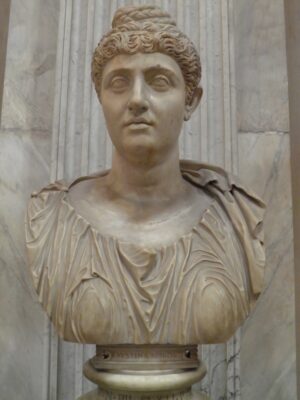
When delving into the life and times of Marcus Aurelius, one of the most influential Stoic philosophers and Roman Emperors, I encounter the name “Faustina” frequently. This recurring name often causes confusion as it refers to not one, but four significant women in his life, and several others as well. Most of the time when I delve into the annals of Roman history, it becomes crucial to distinguish between these figures: Faustina the Elder, Faustina the Younger, Marcus’ sister Faustina, and Marcus’ daughter because many sources just plain have it wrong. The lineage goes: his mother-in-law, Faustina the Elder, his wife, Faustina the Younger, her sister who was Fautina I, and their daughter. And, here’s the kicker, all four had the ear of the emperor so their names are etched into history right along side his.
To the right is the Colossal portrait of Faustina the Elder, from the Pantanello at Hadrian’s Villa, 138-140 CE, Vatican Museums, Rome (ref. 9459345263). Upon her death, coins depicting her were issued including the following issue from 141-61 CE.
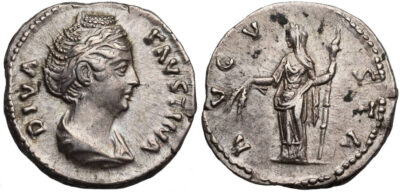
Marcus Aurelius’ wife, often known as “Faustina the Younger,” to differentiate her from her mother, “Faustina the Elder.” But also sometimes as “Faustina II” to differentiate her from her sister. Marcus and Faustina the Younger had a daughter named Faustina, often referred to as Annia Galeria Aurelia Faustina, carrying on the family tradition.
Faustina I the Elder, 138-141 AD, AR Denarius, Ceres, Posthumous Issue, struck 141-161 AD
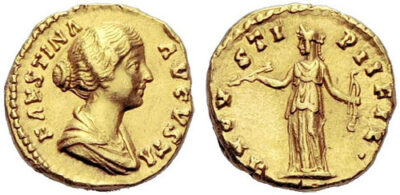
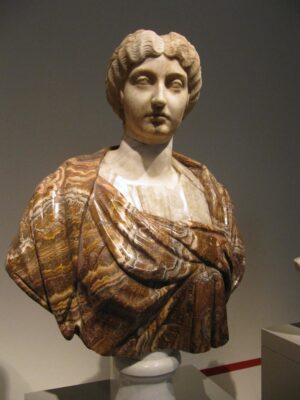
Faustina the Younger, Marcus Aurelius’ wife, married the future Emperor in 145 CE, and her death in 175 CE preceded that of her husband by five years. These dates are critical markers that help us accurately identify Faustina the Younger in historical documents. Faustina the Elder, her mother, passed away earlier in 141 CE, four years before her daughter’s marriage to Marcus.
This clarification is necessary due to several accounts circulating in modern retellings of this historical period. Some tales inaccurately suggest that Faustina the Younger participated in Marcus’s downfall or attempted to remarry before his death, believing him dead. Others wrongly claim she remarried after Marcus’s demise. Given that she predeceased Marcus by five years, these accounts are chronologically impossible.
For example, the HBO show The Roman Empire (2000) portrays Faustina the Younger as a scheming and ambitious woman who is willing to do anything to protect her own interests. She is also shown to be having an affair with a gladiator, which further undermines her reputation. However, this portrayal is not entirely accurate. While it is true that Faustina was associated with some of the people who were later accused of plotting against Marcus Aurelius, there is no evidence that she herself was involved in any plots. Additionally, the show’s depiction of Faustina’s affair with a gladiator is based on speculation, and there is no historical evidence to support it. Overall, the portrayal of Faustina in The Roman Empire is inaccurate and misleading. This show is an example of bad historical fiction.
In terms of Faustina the Younger’s betrayal, this could refer to the historical rumors of her alleged affair with a general named Avidius Cassius, who revolted against Marcus Aurelius, and these events, if they occurred, would have occurred during Marcus’s lifetime, and not after Faustina’s death. Meaning, fair fodder.
Also, the movie “Gladiator” from 2000 plays loose with historical facts for the sake of drama. For instance, the movie depicts Marcus Aurelius’ son Commodus as his murderer, which isn’t accurate at all. Again, bad historical fiction.

Weekly Wisdom Builder
Got 4 minutes a week?
A new 4-minute thought-provoking session lands here every Sunday at 3PM, emailed on Mondays, and shared throughout the week.
Exactly what the world needs RIGHT NOW!
Marcus Aurelius Birth Family
Marcus Aurelius was born on April 26, 121 CE, in Rome to an aristocratic family. His father, Marcus Annius Verus, and his mother, Domitia Lucilla, were both from prominent and noble lineages. Tragedy struck early in the life of Marcus Aurelius when his biological father passed away in 124 CE, leaving him fatherless at the young age of three. However, fortune favored the young Marcus. As Marcus grew up, the Roman Emperor Hadrian took notice of his potential and arranged for him to be adopted by his paternal relative, Lucius Aelius, who was then designated as Hadrian’s successor. Marcus was likely around 14 or 15 years old when he was adopted and put inline to potentially become emperor.
Marcus had one biological sister that for sure outlived him and they were close. He had other siblings too but they all died young. His sister, the other Faustina Minor, was executed by Commodus, Marcus’ son in 182. Well, that’s the leading story and it is in the history books, but in a way that is a little speculative. I hope to dig into that at some point to see how valid. For now, here is his biological family.
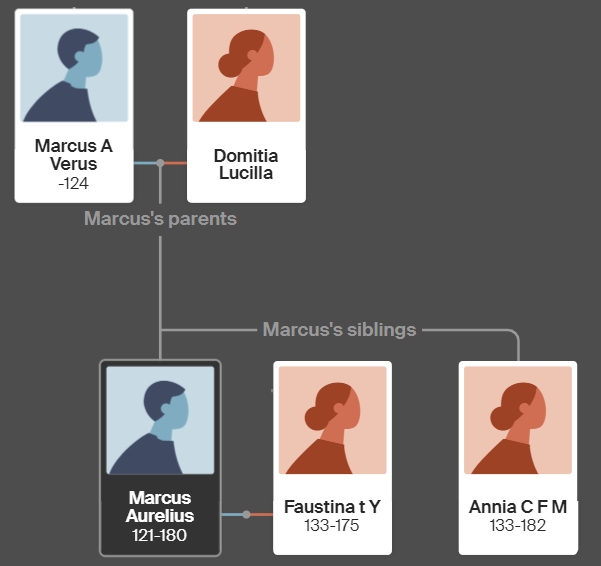
Marcus’ First Adopted Family: Lucius Aelius
Lucius adopts Marcus. In early 138 CE, his adopted father Lucius Aelius died unexpectedly. Of note, while Lucius Verus is the biological son of Lucius Aelius, Lucius Verus was adopted by Antoninus Pius, at the behest of Hadrian, after Lucius Aelius’s death.
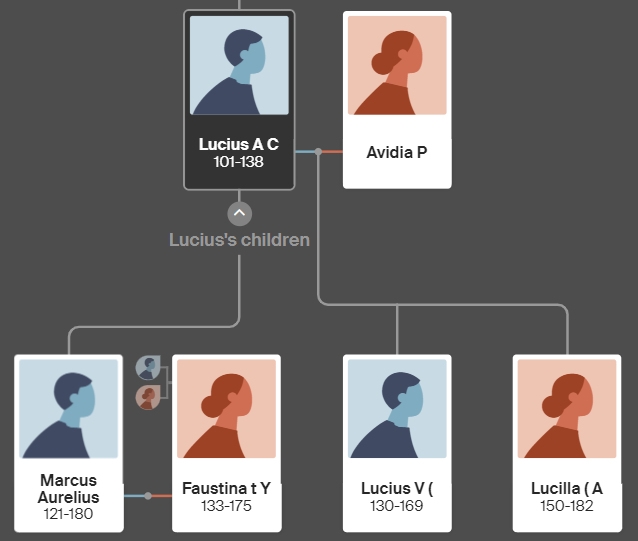
Marcus’ Second Adopted Family: Antoninus Pius
Pius adopts Marcus to keep him in line to the throne. The aged Hadrian felt the need to stabilize the line of succession. He adopted Antoninus Pius as his son making him his new successor, under the condition that he adopt Marcus Aurelius and Lucius Verus (first step-dad’s son) as his own successors. This arrangement ensured a stable line of succession.
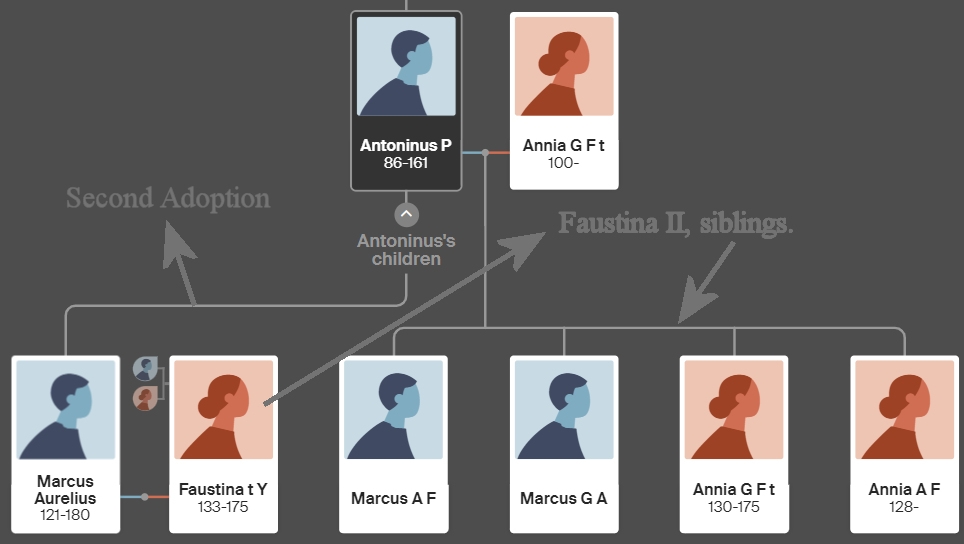
Marcus Aurelius and Faustina the Younger’s Family
Hadrian’s arrangement for Marcus to be adopted a second time made it pretty clear to history that Hadrian wanted Marcus Aurelius to be among those considered to become emperor. This second adoption secured his place in the line of imperial succession. Marcus was about 17 years old at this time. His new adopted sister Faustina the Younger was around 11 years old. Hadrian passed away later that year, in July and Antoninis Pius ascended to the throne. In 145 CE, about seven years later, when Marcus is about 24 and Faustina is about 18, they get married.
Upon the death of her father and his second step-dad, Antoninus Pius, in 161 CE, Marcus Aurelius ascended to the throne as the new Roman Emperor. Demonstrating his commitment to fairness and shared responsibility, he named his adoptive brother, the biological son of his first step-dad, Lucius Verus, as his co-emperor . This decision demonstrated his adaptability and willingness to apply Stoic principles in an unconventional manner. This arrangement continued for about eight years until Lucius Verus’ death from a sudden illness, possibly food poisoning or the plague, after which Marcus Aurelius ruled the empire alone, but legend says that his wife Faustina was well-respected, played a significant role in courtly life, and was a trusted advisor to her husband. Their marriage was marked by mutual respect and loyalty.
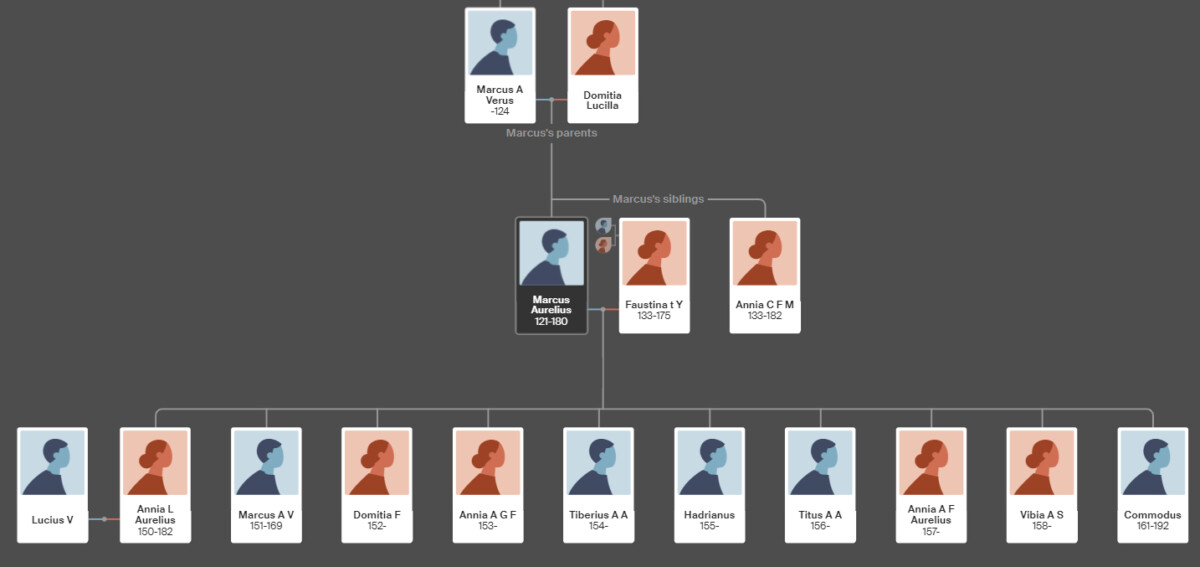
Unraveling this historical knot helps to clarify the narrative surrounding Marcus Aurelius’ life and the women who influenced him. The Faustinas, while sharing a common name, lived distinct lives and had unique impacts on their society and the man who has left us the profound wisdom found in “Meditations.”
Marcus’ second step-dad, Antoninus Pius, was deeply in love with his wife, Faustina the Elder. Upon her death, he went into deep mourning and had her deified. Temples were dedicated to her, and coins were minted with her portrait (see my new coins I purchased below). This profound devotion was also evident when he asked the Senate to deify his wife and even founded a charity in her name called “Alimenta Faustiniana” for orphaned girls.
Antoninus Pius’s devotion to his family, and the stability of his reign, provides a contrast to some of the more tumultuous periods in Roman history. His rule is sometimes seen as a “golden period” sandwiched between the notable reigns of Hadrian and the philosophically inclined Marcus Aurelius.

Understanding these details helps illuminate the socio-political landscape of the Roman Empire during the reign of Marcus Aurelius. It also serves as a reminder that while history often focuses on the lives of kings and emperors, the women surrounding them, even those sharing a common name, have their own stories of strength, influence, and resilience.
When examining the life of Marcus Aurelius, remember the Faustinas. Use the dates of their lives as anchors in the flowing river of historical records. By doing so, we can bring accuracy to our understanding of this complex era and honor the distinct roles each of these women played in shaping one of history’s most revered philosophers and leaders.
— map / TST —















